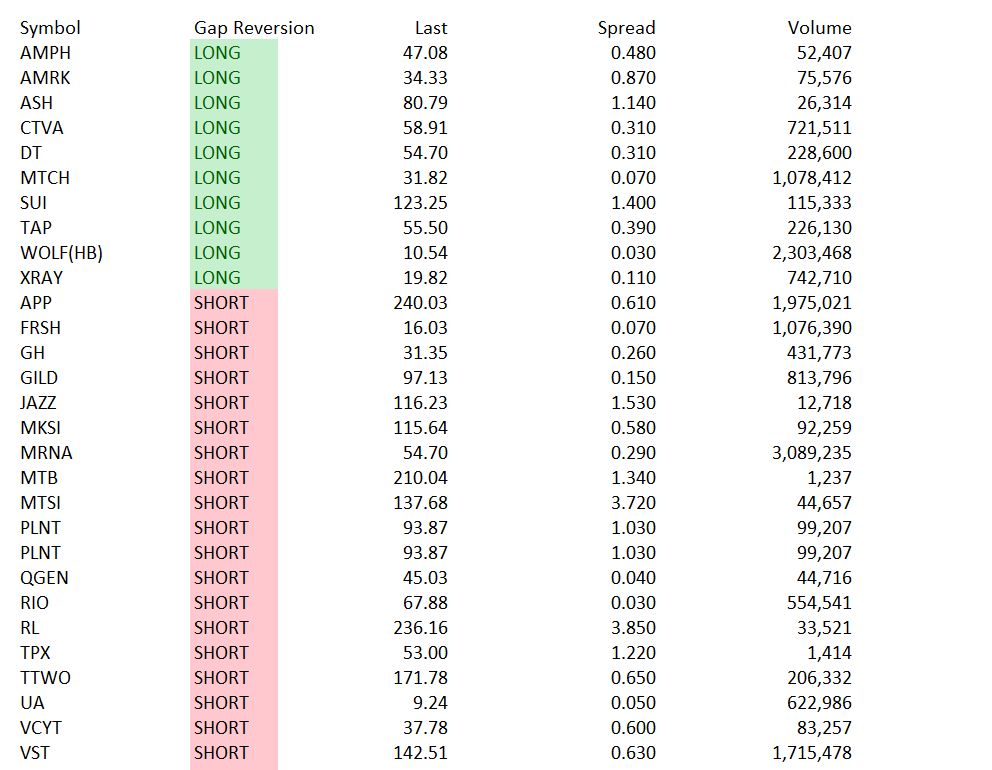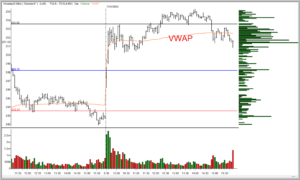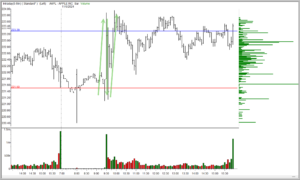The Small Cap Swing Trader Alert Archive
Below you'll find The Small Cap Swing Trader setups stacked up and ordered chronologically.Using Intraday VWAP in Day Trading
A Guide to the Volume Weighted Average Price Strategy
The Volume Weighted Average Price (VWAP) is a widely-used technical indicator in day trading, especially for stocks. Calculated as a ratio between total dollars traded and total volume, VWAP gives insight into a stock’s average price based on volume throughout the trading session. Unlike a simple moving average, VWAP considers the volume of each trade, making it a useful tool for assessing the true average price over a specific period. In this article, we’ll explore the concept of intraday VWAP and how traders can leverage it to enhance their day trading strategies, with examples to clarify its application.
What is Intraday VWAP?
Intraday VWAP is calculated for the entire trading session and reset daily. The formula is straightforward:
VWAP=∑(Price x Volume)∑VolumeVWAP = \frac{\sum \text{(Price x Volume)}}{\sum \text{Volume}}
This calculation provides a dynamic benchmark reflecting price and volume over the day. The result is a line plotted on the chart that reflects the average price weighted by volume, helping traders identify where most trades happen relative to the stock’s price.
VWAP is particularly useful for day traders and institutions. It reveals whether a stock is trading above or below its average price, which is key in making buy or sell decisions.
How Intraday VWAP is Used in Day Trading
1. Benchmarking Fair Value
VWAP helps traders gauge a stock’s fair value intraday. If the price is above VWAP, buyers have more control; if the price is below VWAP, sellers dominate. This benchmark is valuable when traders want to assess the overall strength of price action.
- Example: Let’s say Tesla (TSLA) opens strong, with the price trading above VWAP for most of the morning. For a day trader, this indicates bullish strength, meaning buying dips closer to VWAP could offer an advantageous entry point in line with the prevailing trend.
2. Identifying Optimal Entry and Exit Points
VWAP can be used to pinpoint intraday entry and exit points, as it often acts as support or resistance. A common strategy is to buy when a stock price approaches VWAP from above, as it can serve as a support level. Conversely, a stock price approaching VWAP from below can serve as resistance, indicating a potential exit point.
- Example: Imagine that Apple (AAPL) is in an uptrend but has temporarily returned to its VWAP line midday. A day trader may buy AAPL as it touches VWAP, expecting the uptrend to continue. If AAPL bounces off VWAP and moves higher, it confirms the support level. Conversely, if AAPL breaks below VWAP, it may indicate a reversal, signaling the trader to cut losses.
3. Trend Confirmation Tool
VWAP is often used as a trend confirmation tool. The trend is considered bullish when prices remain above VWAP, whereas prices consistently below VWAP suggest a bearish trend. Day traders can use VWAP in conjunction with other indicators to confirm their outlook.
- Example: A trader notices that Microsoft (MSFT) has been trending above VWAP throughout the day, reinforcing the bullish sentiment. They may hold onto long positions, only selling if MSFT breaks below VWAP, signaling a potential trend change. This approach can help maximize gains by staying aligned with the prevailing trend.
4. Minimizing Slippage for Institutional Trades
For larger traders and institutions, VWAP is a benchmark to gauge trade execution quality and minimize slippage. Institutions may strive to buy below VWAP and sell above it, which allows them to ensure that they’re trading at advantageous prices relative to the day’s volume-weighted average.
- Example: A hedge fund managing a large position in Amazon (AMZN) might split its orders over the day, striving to buy at or below VWAP. This minimizes market impact, allowing the institution to accumulate shares without paying above the stock’s average price for the day.
Integrating VWAP in a Day Trading Strategy
Step 1: Set Up Your VWAP Indicator
Most trading platforms offer VWAP as a built-in indicator. Plot it on your chart to visualize the stock price’s relative movement to VWAP throughout the trading day.
Step 2: Determine Market Bias
At the market open, observe whether the stock price is trending above or below VWAP. A stock opening and staying above VWAP indicates buying interest and a potential bullish bias, whereas trading below VWAP indicates a bearish bias.
Step 3: Identify Entry and Exit Points
For long positions, wait for pullbacks to VWAP, as it often serves as support in an uptrend. For short positions, consider selling when the stock price approaches VWAP from below in a downtrend, as it may act as resistance.
Step 4: Use VWAP with Stop Losses
VWAP is also useful for stop-loss placements. If you’re long, a break below VWAP can signal weakness, and you may want to exit the trade. Similarly, if you’re short and the price crosses above VWAP, it may indicate strength, signaling you to exit your short position.
Step 5: Avoid Overtrading Around VWAP
VWAP works best when the price interacts with it occasionally. Avoid overtrading when the price is tightly fluctuating around VWAP, as reading clear signals can be more challenging.
Real-World Example: VWAP in Action
Consider a scenario with Nvidia (NVDA) stock. Suppose NVDA opens the day with strong buying and quickly moves above VWAP. As NVDA trends upward, a trader watches for any pullback toward VWAP to establish a long position. Around midday, NVDA pulls back and touches VWAP, bouncing off it and continuing its upward trend. This support level confirms VWAP as a strong entry point, and the trader can ride the momentum.
Later, if NVDA fails to hold VWAP and breaks below it, the trader might consider this a reversal signal and exit the position to lock in profits. This intraday example illustrates how VWAP is both a support level and a trend confirmation tool.
Final Thoughts
The intraday VWAP is an essential indicator for day traders. It provides insight into fair value and guides entry and exit points. VWAP’s use as a support and resistance level, combined with volume-weighted insights, makes it a powerful tool for day trading strategies. Whether used alone or with other indicators, VWAP offers a clear visual of a stock’s strength and trend direction, helping traders make more informed decisions.
Like any indicator, VWAP is most effective when used with sound risk management and additional analysis. By understanding VWAP’s dynamics, traders can gain a valuable edge in navigating intraday stock price movements.
Good Trading,
Adrian Manz
Understanding Apple’s Intraday Price Patterns and the Role of Options Market Makers
Understanding AAPL’s Intraday Price Patterns
If you’re an active trader or investor following Apple Inc. (AAPL), you’ve likely noticed a recurring intraday price pattern: AAPL often surges at the open, retraces to premarket support levels, and then resumes an upward move, often retesting the initial high. This sequence isn’t just a coincidence or random volatility; it reflects underlying market dynamics influenced by demand and supply pressures, including the role of options market makers who hedge their positions. Understanding AAPL’s intraday price patterns and these forces can help you better anticipate AAPL’s price behavior and refine your trading strategies.
The Initial Surge: Buying Pressure and Market Sentiment
Apple is one of the market’s most liquid and widely traded stocks, making it highly responsive to market sentiment and external events. When trading opens at 9:30 a.m. EST, the price often experiences an immediate surge. A few key factors typically drive this movement:
- Overnight News and Market Sentiment: Events that unfold overnight, such as global economic data, geopolitical developments, or tech sector earnings reports, can dramatically shift investor sentiment. These shifts create pent-up demand that manifests as soon as the market opens. Traders who react to news after hours are eager to execute their buy or sell orders at the open, often causing sharp initial moves in the stock price.
- Market Orders and Volume Spikes: The opening bell sees a significant influx of market orders. Retail investors, hedge funds, and institutional investors place orders based on premarket trends, research, and overnight news. If sentiment is positive, these opening trades add substantial buying pressure to AAPL, pushing prices higher initially.
- Options Market Makers and Delta Hedging: Here’s where the mechanics of options come into play. Market makers who sell call and put options strive to stay delta-neutral, meaning they offset their exposure to directional moves in AAPL’s stock price by adjusting their stock holdings accordingly. At the open, if AAPL gaps up or shows strength, these market makers must buy shares to hedge the call options they sold. This buying, particularly in a stock as liquid as AAPL, can push prices higher in the opening minutes, contributing to the initial surge.
The Opening Retracement: Profit-Taking and Reduced Hedging Demand
After the initial surge, AAPL often retraces toward premarket support levels, a common technical behavior that signals a temporary easing in buying demand. Several factors fuel this pullback:
- Profit-Taking: The early spike in AAPL’s price provides a quick profit opportunity for traders who bought at the open. These early entrants often take profits soon after the surge, especially if their strategy is based on intraday momentum or scalping. This wave of selling pressure contributes to a retracement as demand weakens temporarily.
- Options Market Makers Adjusting Hedging Needs: The intense buying pressure tapers off once market makers have adjusted their delta hedges to account for the initial spike. Their need to purchase shares diminishes as AAPL stabilizes, leading to a momentary lull that allows the price to retreat to support levels. The impact of delta hedging is particularly significant in a stock like AAPL, which has high options trading volume and attracts traders and market makers alike.
- Testing Technical Levels: Many traders rely on technical analysis, and premarket support levels act as psychological floors for the stock. As AAPL pulls back, these levels attract new buyers and provide a base from which the stock can begin a secondary move.
The Secondary Move: Testing Highs and Renewed Buying Pressure
After a pullback to premarket support, AAPL often makes a second move, climbing back to the initial high established right after the open. This secondary push can be attributed to both technical factors and renewed hedging activity:
- Renewed Buying Interest and Technical Patterns: Traders who follow technical patterns may see the retracement as an opportunity to buy at support, creating a double-bottom formation that suggests further upside. Additionally, the initial high of the day serves as a natural resistance level, providing a target for this secondary upward move.
- Continued Hedging Adjustments by Market Makers: As AAPL’s price moves, options market makers continually adjust their delta hedges. If AAPL bounces off support levels, market makers may need to buy shares again to offset exposure, especially if the stock regains momentum. This renewed hedging activity creates upward pressure, which can return AAPL to its earlier highs. Market makers’ actions are more pronounced on days with high options volume and open interest, particularly near expiration dates.
- Self-Fulfilling Prophecy for Resistance: The initial high often becomes a short-term resistance level. This behavior draws in traders who use resistance as a selling or take-profit target, reinforcing the retest. Additionally, algorithmic trading models and high-frequency trading (HFT) systems are designed to capitalize on these predictable patterns, further reinforcing the price action.
Why This Pattern Matters to Traders
For active traders, understanding AAPL’s intraday price patterns can be advantageous:
- Timing Entries and Exits: Recognizing the likelihood of an initial surge, followed by a retracement, and then a secondary rise can help traders plan more precise entry and exit points. Traders who buy during the retracement may enjoy a better risk-reward ratio than those who chase the stock during the initial spike.
- Setting Realistic Profit Targets: If you’re targeting a retest of the opening high, this pattern provides a clear framework for setting profit goals based on past behavior. Setting realistic expectations allows for more disciplined trading.
- Leveraging Options Data for Insights: Observing options open interest and tracking delta exposure can reveal when market makers need to hedge, providing further insights into potential price movements. Elevated options volume or large open interest near key strike prices can indicate whether these moves will likely be amplified.
Final Thoughts
The intraday pattern of Apple’s stock—a surge, retracement, and second rise—reflects a mix of market psychology and options market maker activity. The role of delta and gamma hedging in highly traded stocks like AAPL cannot be understated; it creates demand dynamics that influence intraday price action. For traders who can recognize these patterns, there are opportunities to capitalize on predictable moves, particularly when combining technical analysis with insights into options market behavior.
By understanding the “why” behind these intraday moves, traders can better position themselves to ride Apple’s waves of demand and potentially improve their trading outcomes. As always, remember that market patterns aren’t guarantees but probabilities—staying flexible and adaptive is key.
Good Trading,
Adrian Manz
November 7, 2024

The Power of Focused Attention in Day Trading
Ready, Set, Focus Your Attention!
In the high-stakes world of day trading, where every second counts and market conditions shift in the blink of an eye, focus is not just an asset—it’s essential. As traders, our ability to stay centered, alert, and attentive in the moment can be the key to consistent success. However, maintaining this intense concentration over extended periods requires discipline and training. Performance psychologists and mental conditioning experts like Eddie O’Connell emphasize that cultivating focus is as critical for traders as it is for athletes.
Why Focus Matters in Day Trading
Day trading demands quick decision-making and an ability to tune out distractions. With multiple screens, fluctuating stock prices, and the constant influx of market news, it’s easy to lose concentration. When a trader’s attention wanders, even for a second, it can lead to costly mistakes—missing an entry point, misinterpreting a chart pattern, or failing to adjust a position. Focused attention allows traders to react to the markets precisely, grounding each decision in data rather than impulse or distraction.
Performance psychologist Eddie O’Connell highlights this need for undivided focus: “In high-stress environments, the ability to filter out non-essential information and maintain attentional control directly impacts performance outcomes.” O’Connell’s words ring true in trading. Just as athletes learn to block out the crowd’s noise to hit a free throw, traders must train to ignore distractions and focus solely on the data, charts, and signals that matter most.
The Science of Focused Attention
Research shows that focus can be cultivated and strengthened over time. The brain is adaptable and capable of improving concentration through consistent practice and techniques like mindfulness, visualization, and intentional rest periods. This could mean dedicating morning time to mental exercises that enhance alertness and concentration in trading.
Focused attention also involves managing emotions and avoiding the cognitive traps that can arise from trading. Emotional responses, like fear and greed, often disrupt focus. A spike in a stock may tempt a trader to abandon their strategy, leading to impulsive decisions. By training focus, traders can learn to observe these emotions without reacting to them, allowing them to stick to their plan and make rational decisions.
Tips for Improving Focused Attention in Trading
- Create a Focused Environment: Set up a clutter-free trading space. Limit distractions like social media, personal devices, or anything else that could distract you from the markets. A dedicated workspace tells your brain it’s time to focus.
- Practice Mindfulness: Before the trading day begins, take a few minutes to center yourself. Deep breathing or meditation can help you bring your mind to a calm, focused state, ready for the trading session.
- Use Visual Cues: Charts, indicators, and screens should be organized to draw your attention to the most important information. Create a system for identifying key signals without clutter or overload, keeping you focused on the essentials.
- Take Breaks: Trading can be mentally exhausting. Step away during non-peak times to recharge and reset. Short breaks throughout the day can improve overall focus and decision-making.
- Reflect and Review: At the end of each trading day, evaluate your performance. Note any lapses in focus and think about how you can improve. Reflection helps solidify what you’ve learned and reduces the likelihood of repeating mistakes.
Focused Attention as a Competitive Edge
Focused attention is more than just a tool; it’s a competitive edge. Traders who consistently apply their attention to the right tasks without being pulled in different directions are better positioned to act on opportunities that others miss. By honing this skill, you set yourself apart in a market where every decision counts.
In Eddie O’Connell’s words, “The key to peak performance lies in one’s ability to be fully present in the moment.” For day traders, mastering this skill can make the difference between a good trade and a great one, leading to sustained success over time. So, let’s prioritize focused attention, using it to sharpen our reactions, execute strategies flawlessly, and stay grounded in the fast-moving world of trading.
Good Trading,
Julie Manz
What Trump’s Victory Means for Stock Market Traders
In the wake of Donald Trump’s recent victory, the markets are bracing for shifts traders need to anticipate. Trump’s policies and leadership style have historically impacted various market sectors, and his return will likely influence trading strategies across the board. As we move forward, let’s break down what traders should consider, focusing on the “Magnificent 7” stocks, the biotech sector, and broader indices like the QQQ and SPY.
The “Magnificent 7” Stocks
The “Magnificent 7” – a select group of tech giants that have driven market growth in recent years – could experience mixed impacts. Trump’s economic policies favor deregulation and corporate tax cuts, which are traditionally positive for large-cap tech companies. However, traders should be mindful of potential policy shifts around international trade and relations with China, as these companies rely heavily on global supply chains and international sales. Any disruptions in trade relations could affect these giants’ bottom lines.
Moreover, the Trump administration’s stance on immigration and H-1B visas might affect the talent pipelines tech companies rely on, potentially slowing innovation. For traders, this means that while these stocks may have a short-term boost, monitoring policy changes and staying nimble with positions is wise.
Biotech Stocks
Historically, Trump has had a somewhat hands-off approach regarding the pharmaceutical industry, favoring deregulation and fostering a more business-friendly environment. Biotech stocks may see an initial lift from his victory as investors anticipate fewer regulatory hurdles and a speedier approval process for new drugs. However, there could be volatility if the administration pushes back on drug pricing, especially if consumer pressure mounts.
For those trading biotech, this means potential short-term gains with opportunities for profit-taking, but a cautious approach to long-term holds may be warranted due to pricing uncertainty.
QQQ and NQ
The Nasdaq-100 index, represented by the QQQ, could initially rally on news of Trump’s victory, as his policies traditionally favor growth stocks, particularly in technology. However, as with Magnificent 7, the QQQ is sensitive to global trade tensions, which could arise depending on Trump’s approach to China and other economic competitors.
For traders, this presents an opportunity to benefit from initial enthusiasm in tech-heavy indices, but volatility may rise in the longer term if international trade issues resurface. A strategy that includes close monitoring of news related to trade and international relations will be key.
SPY and ES
The SPY, representing the S&P 500, tends to reflect broader market sentiment and may see a mixed reaction. Trump’s victory might boost financial stocks, strengthening the SPY, especially if interest rates remain elevated. Other sectors, such as industrials and energy, could also benefit from his infrastructure and deregulation policies, potentially boosting the index.
However, investors need to be wary of a potential increase in sector rotation. For example, there may be a shift from high-growth to value sectors, particularly if inflation concerns continue. Traders should be ready to adjust positions within the SPY to capture these shifts, utilizing tools like sector ETFs to maintain flexibility.
Trading Takeaways
Stay Agile with the Magnificent 7: Tech giants may see initial gains, but volatility around trade policy means traders should be ready to adjust positions as needed.
Be Selective with Biotech: Opportunities for short-term profit-taking could arise, but long-term holds may carry risks if drug pricing debates resurface.
Monitor QQQ for Trade Tensions: Initial gains in the Nasdaq-100 could be tempered by potential trade issues, so keep an eye on news related to international relations.
Position for Sector Rotation in SPY: Be prepared for sector rotation within the SPY, and consider adjusting your allocations in response to potential shifts from growth to value stocks.
Trump’s victory is bound to introduce some turbulence, but for intraday traders, this will create the kind of volatility that brings opportunity. Daily price swings driven by news shocks will likely generate strong momentum, allowing traders to capitalize on sharp, directional moves. The key in this environment is patience: letting the market settle in after the opening bell and waiting for stocks to establish critical inflection points at support and resistance areas.
When these levels align with other indicators of resting order flow, they create ideal entry points for high-probability trades. By focusing on these confluence zones, traders can position themselves to ride the waves of intraday momentum, making the most of the heightened activity this new political landscape will likely bring. Trading the established zones offers a disciplined way to capture gains while keeping risks in check amid daily fluctuations.
Good Trading,
Adrian Manz
How Overnight Futures Influence the Next Day’s Stock Market
What Are Overnight Futures?
Overnight futures represent contracts to buy or sell an index or commodity at a specified price in the future. Futures on indices like the S&P 500, Nasdaq, and Dow Jones give investors a sense of market direction before regular trading hours. Unlike stocks, which trade for only part of the day, these futures are active nearly 24/7, reacting immediately to international news and global economic indicators.
Key Influences of Overnight Futures on the Stock Market
1. Setting the Tone for Market Sentiment
Futures trading overnight can reflect whether investors are optimistic or anxious, setting a “tone” for how the stock market might open the next day. For example:
- Positive Economic Data or Earnings: If a major company reports strong earnings after hours, futures for the relevant index may rise. Similarly, positive data from foreign markets can create bullish sentiment, leading to higher futures prices.
- Negative News: News such as geopolitical tensions or weaker-than-expected earnings results can cause futures to decline. This decline often signals that the market may open lower.
Example: Suppose Apple (AAPL) and Microsoft (MSFT) report strong earnings after the close, and the S&P 500 futures rise 0.5% overnight. This positive futures movement suggests that investors are optimistic, which could result in a “gap up” for major indices when the market opens.
2. Liquidity and Pre-Market Movement
Overnight futures often guide liquidity, influencing pre-market trading and price discovery in U.S. markets. Investors and institutions use futures to position themselves before the stock market opens. This positioning creates liquidity that helps set early price levels, particularly when significant news has occurred overnight.
Example: After a surprise interest rate cut by the European Central Bank (ECB), S&P 500 futures may rise as investors anticipate a boost to global economic growth. By the time U.S. markets open, stocks in rate-sensitive sectors, like banks and real estate, may already have moved up in pre-market trading due to the initial price levels established by futures.
3. Influence on the Opening Gap
An overnight move in futures can lead to a “gap up” or “gap down,” where the stock market opens significantly higher or lower than the previous day’s close. Gaps occur because futures trading has already “priced in” certain expectations, which can result in sudden price adjustments as soon as the market opens.
Example: Let’s say that during Asian trading hours, oil prices surge due to an unexpected supply disruption. As oil futures rise, U.S. energy sector stocks may also increase in value. If S&P 500 futures trend up overnight due to this rally, the stock market might open higher, with oil stocks leading the way in a “gap up.”
4. Technical Levels and Resistance
Overnight futures can impact key technical levels like support and resistance, particularly for short-term traders. When futures break through significant levels during the night, these levels can serve as focal points when regular trading begins.
Example: If Nasdaq futures break above a critical resistance level overnight, this move might encourage traders to buy tech stocks once the market opens, as they expect follow-through momentum. Conversely, if futures fail to hold key support overnight, it can signal weakness, prompting traders to be cautious or even sell at the open.
Why Overnight Futures Are Important for Traders
Monitoring overnight futures provides a strategic advantage for traders, especially day traders and swing traders. Here’s why:
- Timing Trades: Futures can help traders anticipate where the market might open, allowing them to set up trades around anticipated gaps or price adjustments.
- Understanding Market Sentiment: Futures glimpse global sentiment and potential volatility. Traders can adjust their strategies accordingly, depending on whether the market is expected to be bullish, bearish, or neutral.
- Identifying Key Levels: Futures levels often align with intraday support or resistance zones, creating predictable levels traders can use for entry and exit points.
Real-World Example: How Overnight Futures Impacted the Market
Consider a scenario in 2023 when the Federal Reserve released surprising inflation data. After regular U.S. trading hours, Asian markets reacted swiftly, causing U.S. futures to drop sharply. The next day, when the U.S. markets opened, stocks gapped down due to the overnight movement in futures. Pre-market trading had already anticipated this decline, but the confirmation came as the stock market opened lower in response to futures that had already “pricing in” the Fed’s news.
This example highlights how futures can “set the stage” for the day’s trading. Investors and traders who monitored the futures overnight had an edge, as they could prepare for a lower open and adjust their positions accordingly.
Final Thoughts
Overnight futures are a powerful tool for forecasting stock market movements before the opening bell. By observing futures, traders and investors can gauge market sentiment, anticipate potential gaps, and align with key technical levels. As with any market indicator, futures are one piece of the puzzle. However, understanding how they influence the next day’s trading can provide a valuable edge, particularly in volatile or news-driven markets.
Incorporating future analysis into a daily routine can make a significant difference for those who want to stay ahead. Whether you’re a day trader looking for quick setups or a long-term investor evaluating market trends, knowing the influence of overnight futures helps you stay one step ahead.
Good Trading,
Adrian Manz






